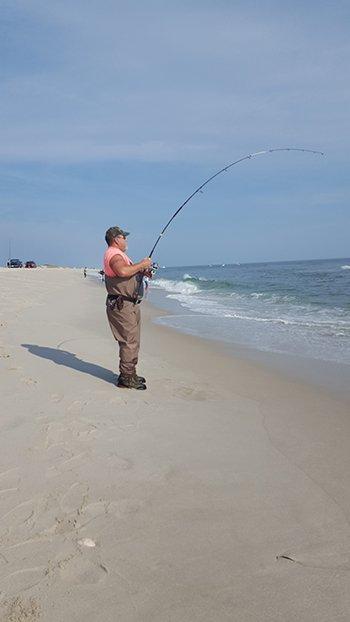Surfcasting for Stripers
They call it surfcasting after all. And to DJ Muller, a noted surfcasting guide and author of four books on the sport, anything that gets in the way of a good, long cast is wasting time and wasting the opportunity to hook up with another giant striped bass. That's why he chooses to fish with SpiderWire braided superlines.
"I have been using SpiderWire for three years now and really like it," says Muller. "I used another braided line for a few years and while that was good, it was not nearly as good as the SpiderWire Stealth and Invisi-Braid lines I use now."
Muller follows the migrations of striped bass along the Northeast coast, ranging from his home base in New Jersey to hot spots from Montauk to Maine. And it is all surfcasting, all the time.
"All I do is surfcast for bass," Muller notes. "I fish recreationally and also guide when the fishing gets good. The surf, rocks and sand complicate things a little bit, but I use all good gear, including submersible spinning reels and 11 foot rods."
A reel that stands up to saltwater and a long rod are the basic tools of the surfcaster, yet Muller feels that paying attention to the line you fish with and how you handle that line is the only way to get the best from your equipment.
"I spend a $1,000 each on my reels, which are in the 8000 to 10000 size, and you have to have a long rod for a long cast, it's just physics," he points out. "Most of all, when you're surfcasting you don't want complaints -- you don't want wind knots, you don't want to see wear on the line -- anything that makes you have to cut off and replace line. Every time you lose line, you lose casting distance."
"SpiderWire is very durable and can stand up to cast after cast after cast," Muller adds. "I try not to get my line in the rocks, but some times a big fish takes your line wherever it wants and SpiderWire has great abrasion resistance.
"Also, when you're casting so much, that means you are handling the line a lot where it comes off the reel. While some other braids are rough, SpiderWire is smooth and easy to handle."
Before getting to the details of how DJ rigs up with SpiderWire, consider the effort he puts forth just to get to his prime fishing locations. He targets deep water with plenty of current and to get to the boulders, rockpiles and points means wading through surf, weeds and sudden dropoffs. He used to use waders and a dry top, but these days pulls on a 5mm full wetsuit with neoprene socks and wading boots with studded cleats for sticking to the top of boulders while making his casts.
While for safety's sake he scouts all his fishing spots during the day, his surfcasting all takes place in the dead of night and the low light of dusk or dawn.
No wonder that once he scrambles up to his prime surfcasting perch, Muller wants everything to work perfectly one cast after another with the minimum of any adjustments or re-rigging. All the energy and time goes to casting -- and hooking up with one striped bass after another.
Here's Muller's rig. He loads up his reel with SpiderWire Invisi-Braid to within 1/8 of an inch of the spool with the line through the guides. He ties the braid to a No. 2 barrel swivel. From the swivel he ties a leader of 80-pound monofilament from 16 to 30 inches long. Attached to that is a fast clip for easily changing out lures.
"The 80-pound is for handling a hooked fish when it gets close and for abrasion resistance on the rocks," says Muller. "Too long a leader and it affects your backcast, too short and you can't handle a big fish. I use shorter leaders in the sand and longer leaders on the rocks. The reason for a longer leader off the rocks is I am not going in the water to get the fish, I have to be able to reach the leader."
Don't let the shock leader fool you into thinking DJ is a heavy tackle fisherman. In fact, he says he has an advantage over other surfcasters because he has all the confidence in the world fishing with SpiderWire's 30-pound braided superlines.
"I use all artificial lures. Most guys start at 50-pound, then go down to 40-pound for distance," Muller notes. "I go for 30-pound test because sometimes you need those extra 20 to 30 yard. Guys are scared of 30 since it is so thin, but you can really pull hard with 30-pound SpiderWire. I'll only go up to 50-pound when I know there are huge fish around."
DJ points out there are two ways to surfcast for striped bass along the Northeast -- you either chase birds and breaking schools of fish or you find what you believe is a natural feeding ground for bass and wait for the fish to come to you.
"I mostly fish at night, so obviously you're not going to see much," says Muller. "I'll just blind cast. I'm always pretty sure the fish are there. Once you hook one or two, I believe the splashing and activity gets the other fish thinking that feeding is going on.
"Then they see the lure."
DJ Muller just finished his fourth book on surfcasting for striped bass. You can find all his books on Amazon.
